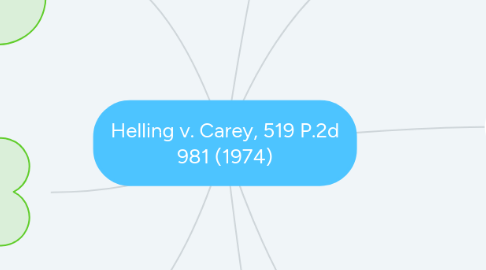
1. Impact
1.1. Chester v. DEEP ROOTS ALDERWOOD, LLC (2016)
1.1.1. Using Helling v. Carey argument was made that using sterile ink was just as easy as using non-sterile ink, as performing the glaucoma test was easy and inexpensive
1.1.2. Courts did not side with Chester
1.2. Truman v. Thomas (1980)
1.2.1. Tried to use Helling v. Carey, however Thomas recommend the pap smear to Truman and she declined, whereas Carey and partner did not recommend the glaucoma screening test
2. Importance
2.1. The courts held the opthalmology practioners liable even though they followed the standard of care for their profession. This poses the question that if a test or procedure is basic and inexpensive to perform and the injury impact is high, should it be performed anyway
2.1.1. What about insurance? Would insurance reimburse the rate of the procedure (even though minimal) if it is not a standard of care of the profession and it is not deemed not medically necessary by the medical standards of the profession?
3. Influence
3.1. Change in practice so that the glaucoma screening is now part of every eye exam
4. Facts
4.1. Parties
4.1.1. Morrison P. Helling, Plaintiff
4.1.2. Thomas F. Carey and Robert C. Laughlin, Defendents
4.2. What happened?
4.2.1. 1959 - Helling consulted with the ophthalmologists for myopia
4.2.1.1. Received contact lenses
4.2.2. 9-1963 - Ophthalmology consult for irritation from contact lenses
4.2.3. 10-1963 - 2nd consult
4.2.4. 2-1967 - 3rd consult
4.2.5. 9-1967 - 4th consult
4.2.6. 10-1967 - 5th consult
4.2.7. 5-1968 - 6th consult
4.2.8. 7-1968 - 7th consult
4.2.9. 8-1968 - 8th consult
4.2.10. 9-1968 - 9th consult
4.2.11. 10-1968 - 10th consult
4.2.11.1. Pressure tested and field of vision for the 1st time
4.2.11.1.1. Diagnosed with glaucoma
4.3. Procedural history
4.3.1. 8-1969 - Defended filed a complaint alleging that her glaucoma and injury were a result of the ophthalmologists negligence
5. Issue Before the Court
5.1. Should the defendants compliance with the standard of care of ophthalmology (lack of requirement in administering pressure or field of vision tests in patients under 40) protect them from liability, when the plaintiff suffered substantial injury of a large portion of loss of her vision
6. Rule of Law
6.1. Negligence - Unintentional failure to follow the standard of care
6.1.1. Duty
6.1.1.1. Standard of care for opthalmologists to adminster the pressure and field of vision test
6.1.2. Breach of Duty
6.1.2.1. Was this standard not followed
6.1.3. Cause
6.1.3.1. Did the ophthalmologists breach (if applicable) cause the injury
6.1.4. Damages
6.1.4.1. What are the damages associated with the breach?
6.2. Strict Liability
6.2.1. Liability without fault, person is held liable for an entirely reasonable mistake
7. Analysis
7.1. Ophthalmology standards of care require that those over age 40 are given a pressure and field of vision test to screen for glaucoma
7.1.1. Less than 1% of those under 40 are diagnosed with glaucoma
7.1.2. 2-3% of those over 40 are diagnosed with glaucoma
7.1.3. Basic and inexpensive pressure and field of vision test
7.1.4. Expert witness testimony confirmed that the defendants were following the standard of care for the ophthalmology specialty
7.1.4.1. Not a case of negligence
7.2. Are the defendants liable through strict liability because of the extreme injury to the defendant
7.2.1. Pressure and field of vision testing is inexpensive and easy to perform
7.2.1.1. Absence of evidence in the record that the test could not have been given in a timely manner
7.2.2. Interesting that the courts are considering proposing a different standard of care than determined by the ophthalmology specialty
7.2.2.1. Reasonable prudence
7.2.2.2. Should the plaintiff have to bear the risk of loss due to the standard of the ophthalmology practice
7.2.3. Should the defendant be entitled to the same protection given to those over age 40 considering the injury
7.2.4. Social justice - who can best bear the loss and to shift the loss by creating liability where there has been no fault
7.2.5. Serves as a compensatory function where the defendant is, through use of insurance, the financially more responsible person
